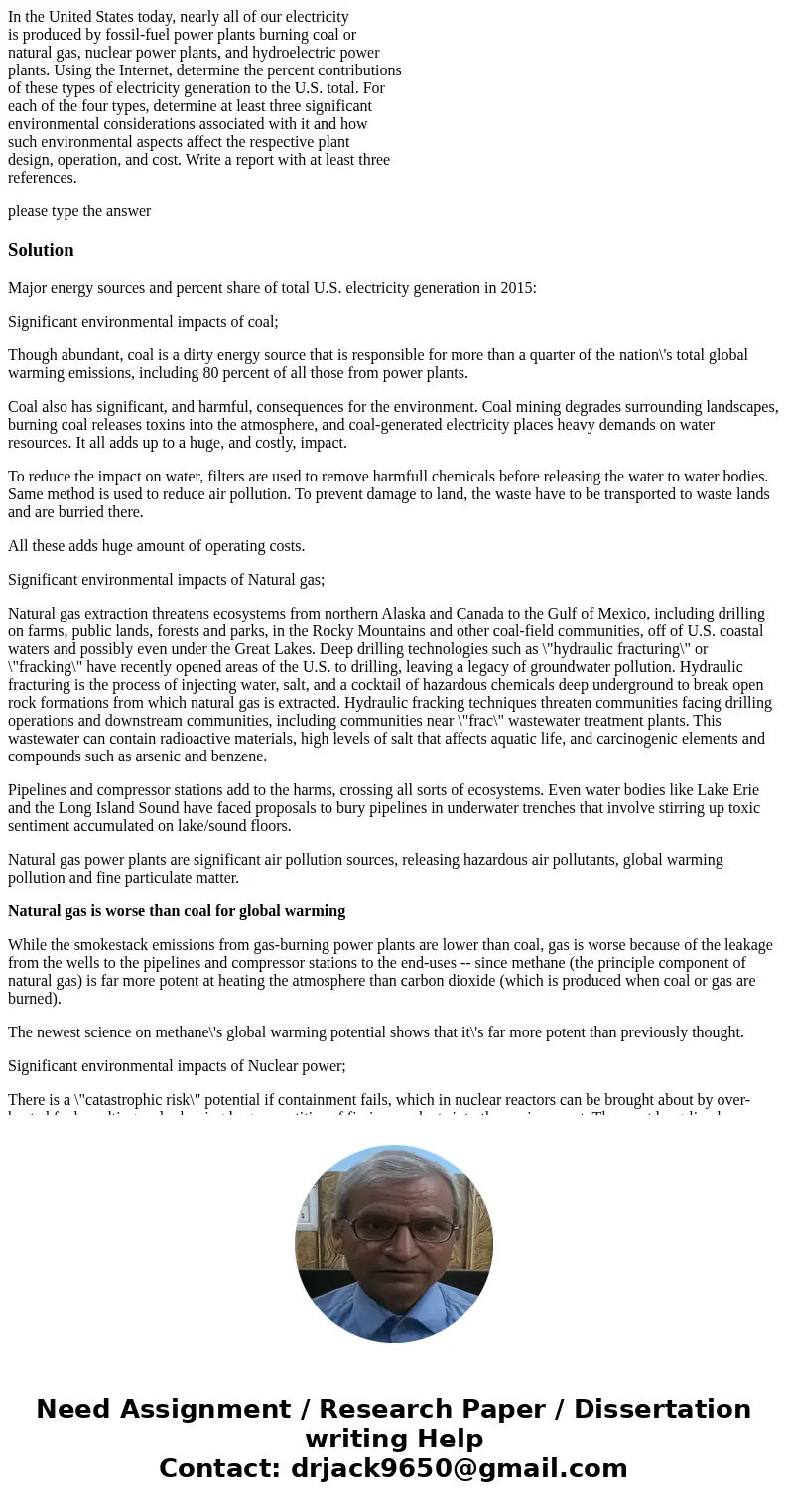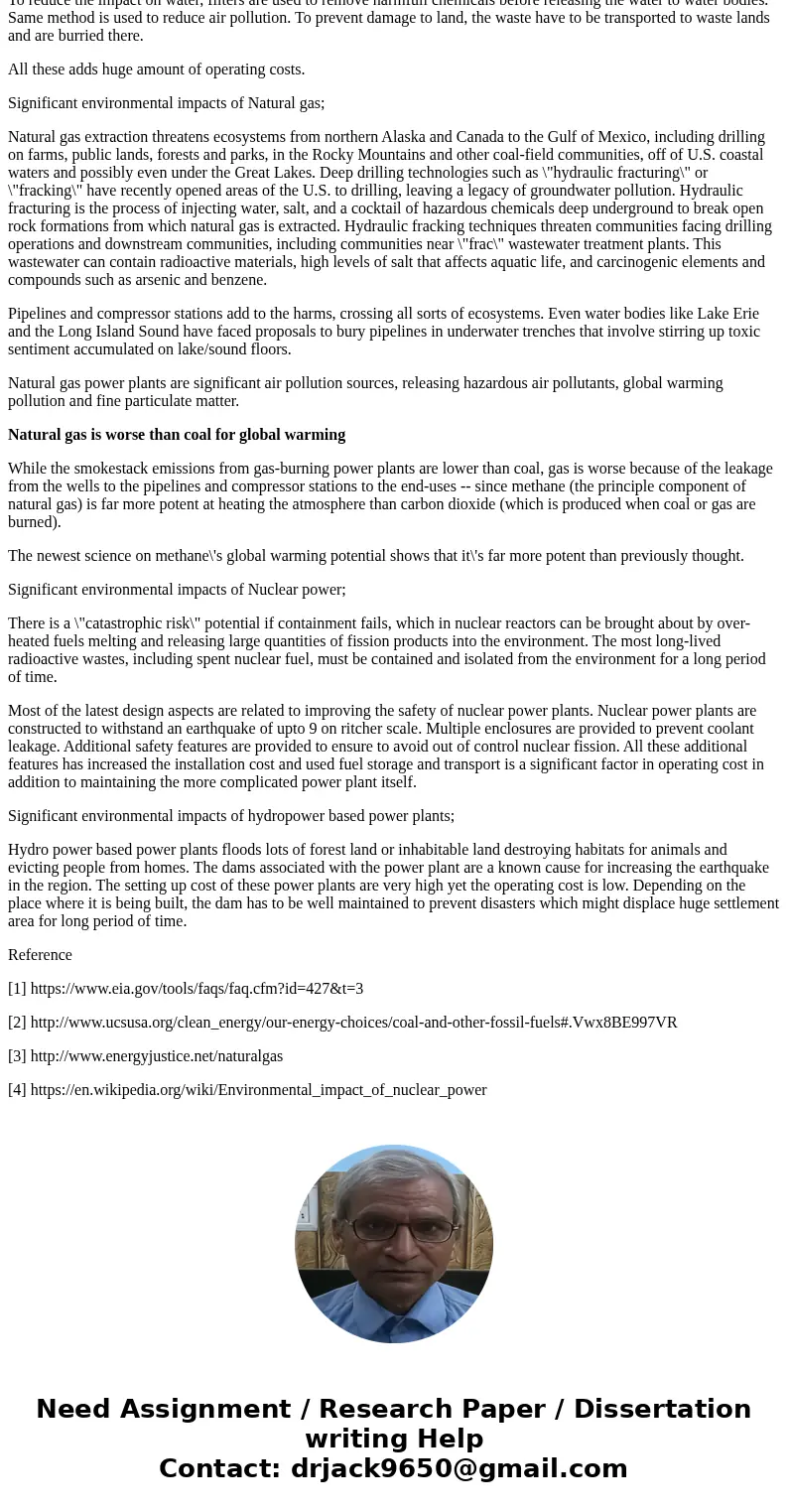In the United States today nearly all of our electricity is
In the United States today, nearly all of our electricity
is produced by fossil-fuel power plants burning coal or
natural gas, nuclear power plants, and hydroelectric power
plants. Using the Internet, determine the percent contributions
of these types of electricity generation to the U.S. total. For
each of the four types, determine at least three significant
environmental considerations associated with it and how
such environmental aspects affect the respective plant
design, operation, and cost. Write a report with at least three
references.
please type the answer
Solution
Major energy sources and percent share of total U.S. electricity generation in 2015:
Significant environmental impacts of coal;
Though abundant, coal is a dirty energy source that is responsible for more than a quarter of the nation\'s total global warming emissions, including 80 percent of all those from power plants.
Coal also has significant, and harmful, consequences for the environment. Coal mining degrades surrounding landscapes, burning coal releases toxins into the atmosphere, and coal-generated electricity places heavy demands on water resources. It all adds up to a huge, and costly, impact.
To reduce the impact on water, filters are used to remove harmfull chemicals before releasing the water to water bodies. Same method is used to reduce air pollution. To prevent damage to land, the waste have to be transported to waste lands and are burried there.
All these adds huge amount of operating costs.
Significant environmental impacts of Natural gas;
Natural gas extraction threatens ecosystems from northern Alaska and Canada to the Gulf of Mexico, including drilling on farms, public lands, forests and parks, in the Rocky Mountains and other coal-field communities, off of U.S. coastal waters and possibly even under the Great Lakes. Deep drilling technologies such as \"hydraulic fracturing\" or \"fracking\" have recently opened areas of the U.S. to drilling, leaving a legacy of groundwater pollution. Hydraulic fracturing is the process of injecting water, salt, and a cocktail of hazardous chemicals deep underground to break open rock formations from which natural gas is extracted. Hydraulic fracking techniques threaten communities facing drilling operations and downstream communities, including communities near \"frac\" wastewater treatment plants. This wastewater can contain radioactive materials, high levels of salt that affects aquatic life, and carcinogenic elements and compounds such as arsenic and benzene.
Pipelines and compressor stations add to the harms, crossing all sorts of ecosystems. Even water bodies like Lake Erie and the Long Island Sound have faced proposals to bury pipelines in underwater trenches that involve stirring up toxic sentiment accumulated on lake/sound floors.
Natural gas power plants are significant air pollution sources, releasing hazardous air pollutants, global warming pollution and fine particulate matter.
Natural gas is worse than coal for global warming
While the smokestack emissions from gas-burning power plants are lower than coal, gas is worse because of the leakage from the wells to the pipelines and compressor stations to the end-uses -- since methane (the principle component of natural gas) is far more potent at heating the atmosphere than carbon dioxide (which is produced when coal or gas are burned).
The newest science on methane\'s global warming potential shows that it\'s far more potent than previously thought.
Significant environmental impacts of Nuclear power;
There is a \"catastrophic risk\" potential if containment fails, which in nuclear reactors can be brought about by over-heated fuels melting and releasing large quantities of fission products into the environment. The most long-lived radioactive wastes, including spent nuclear fuel, must be contained and isolated from the environment for a long period of time.
Most of the latest design aspects are related to improving the safety of nuclear power plants. Nuclear power plants are constructed to withstand an earthquake of upto 9 on ritcher scale. Multiple enclosures are provided to prevent coolant leakage. Additional safety features are provided to ensure to avoid out of control nuclear fission. All these additional features has increased the installation cost and used fuel storage and transport is a significant factor in operating cost in addition to maintaining the more complicated power plant itself.
Significant environmental impacts of hydropower based power plants;
Hydro power based power plants floods lots of forest land or inhabitable land destroying habitats for animals and evicting people from homes. The dams associated with the power plant are a known cause for increasing the earthquake in the region. The setting up cost of these power plants are very high yet the operating cost is low. Depending on the place where it is being built, the dam has to be well maintained to prevent disasters which might displace huge settlement area for long period of time.
Reference
[1] https://www.eia.gov/tools/faqs/faq.cfm?id=427&t=3
[2] http://www.ucsusa.org/clean_energy/our-energy-choices/coal-and-other-fossil-fuels#.Vwx8BE997VR
[3] http://www.energyjustice.net/naturalgas
[4] https://en.wikipedia.org/wiki/Environmental_impact_of_nuclear_power


 Homework Sourse
Homework Sourse